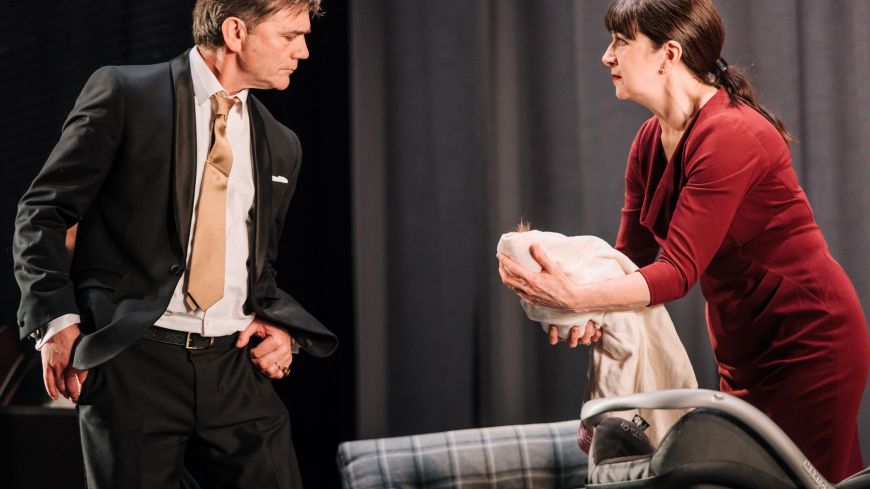
Just when it seemed that Yuletide fripperies had disappeared for another year, the Lyceum curtain lifts to the sweet singing of In the Deep Mid Winter and the sight of a big, tastefully decorated Christmas tree in the corner. So opens the second production in the 2017 season – Shakespeare’s ‘late style’ piece The Winter’s Tale that tells of the perils of a king’s jealousy that result in his and his kingdom’s tragic loss and grief yet in this case resulting in a miraculous redemption.
It’s all party hats, candles and festive drinks in this home where the heavily pregnant Hermione (Frances Grey) is the picture of happiness surrounded by her loved ones, King Leontes (John Michie, his oldest friend Polyxenes (Andy Clark) and their young son Mamillius (played at this performance by Will Robertson). The anachronism of contemporary characters speaking in 16th century language is always a little unsettling but we are accustomed to so called ‘middle class royals’ and the adjustment is quite easy in this case. The horror of Leontes’ drastic action against his wife’s perceived disloyalty starts to impact on those around him creating tension and manoeuvring to save his innocent baby daughter.
The Lyceum may be developing a predilection for plunging the auditorium in to darkness to change scenes as a pitch-black backcloth drops leaving the solitary light from the side stage recording booth containing the musicians playing the strong beautiful and atmospheric Scots tunes. The first half has a claustrophobic feel with the set looking like a store’s furniture department with the sense that if that close curtain that defines a narrow stage were to be opened a rush of shoppers would be seen behind it. Conversely, the second half crashes the fourth wall and the wide stage opens up 16 years later to find the child in her new country and environment.
This production has transposed Sicily and Bohemia for Edinburgh and Fife so the ploy seems a fair one to emphasise an openness in rural life as opposed to narrow rule bound city life. To further emphasise the difference, writer and authoritative Scots language speaker James Robertson has been invited to ‘recast’ this part of the text to allow the rural characters to speak in East Coast Scots. This is a missed opportunity to allow Robertson’s expert translation of the Shakespearean text to vibrant Scots to reflect working class life with dignity rather than cementing it as a vehicle for comedy. The Scots characters are dressed as clowns and buffoons (and indeed balloons), plunging the episode into a Jimmy hatted gala day lampoon with a demeaning panto feel.
The heightened interpretation of the play’s mix of tragedy and comedy makes it detrimentally feel like two distinct pieces. Its salvation is in the principal cast members including Andy Clark as Polyxenes and Frances Grey as Hermione. But it is Maureen Beattie who towers throughout as Paulina while John Michie plots, grieves and ages with equal passion and conviction. He does this despite having to sit towards the end in Havisham style sorrow with a plastic shrouded Christmas tree like a scene from the Top Tips page of the Viz. The play’s ending and its message of fairy tale hope beyond life’s harsh realities also redeem this overlong production.
10 February – 4 March 2017 at 7.30pm with matinees at 2pm

